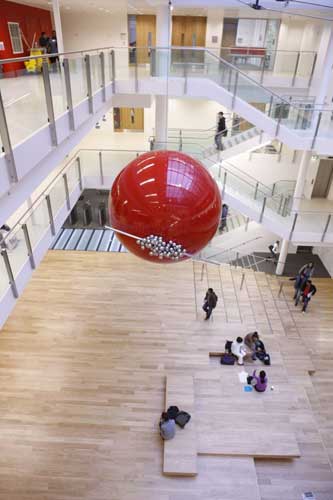The LSE's jaw-dropping £71m structure is a building to wow students
The LSE has put up a beautiful modern structure to provide more teaching space, offices for academics and a venue for public events. All happy? Not quite.

Your support helps us to tell the story
From reproductive rights to climate change to Big Tech, The Independent is on the ground when the story is developing. Whether it's investigating the financials of Elon Musk's pro-Trump PAC or producing our latest documentary, 'The A Word', which shines a light on the American women fighting for reproductive rights, we know how important it is to parse out the facts from the messaging.
At such a critical moment in US history, we need reporters on the ground. Your donation allows us to keep sending journalists to speak to both sides of the story.
The Independent is trusted by Americans across the entire political spectrum. And unlike many other quality news outlets, we choose not to lock Americans out of our reporting and analysis with paywalls. We believe quality journalism should be available to everyone, paid for by those who can afford it.
Your support makes all the difference.Until now, the London School of Economics has been noted for its eggheads rather than its buildings. But that is changing. Earlier this month, the Queen opened a jaw-dropping £71m structure, complete with four lecture theatres, 16 seminar rooms, a street café and a rooftop pavilion with dramatic views across the capital.
Goodbye shabby rabbit warren. Hello sleek, airy modern. The transformation of the handsome Beaux Arts edifice that fronts on to Lincoln's Inn Fields into an 11-storey landmark is the brainchild of LSE director Sir Howard Davies, former chairman of the Financial Services Authority. "It's a wonderful space that at last gives us the academic environment to match our academic reputation," he says.
Designed by architects Grimshaw and built by Osborne, it puts the school on the architectural map. Two departments are housed here – management and law – and the LSE is expanding student numbers by 20 per cent, to 9,000. Also installed here is the Grantham Research Institute on Climate Change and the Environment, chaired by Lord Stern. Finally, the LSE has a space enabling it to justify the sky-high fees it charges for its Masters degrees, and to overseas students.
Or as Davies puts it: "These days, students reasonably expect to be taught in classrooms and lecture theatres with leading edge information technology, and where they can easily hear and see the lecturer."
At the building's centre is a soaring three-storey, glass atrium that lets in copious amounts of natural light and gives a sense of grandeur and fluidity that the former Edwardian building lacked. The atrium's stepped timber floor swooping up one wall is a nice design flourish that softens the hard edges and complements the tiered seating. Students hang out on this floor. It is the heart of the building, a large and welcoming space that invites you to sit in it. On either side are the entrances, one that leads into Kingsway, the other into Lincoln's Inn Fields, so you can see right through.
Staircases climbing up both sides of the atrium are open, in contrast to the stairwells at the LSE's old building in Houghton Street which are dark and closed-in. And there numerous windows letting in more light and showing the school to the outside world. The effect is to open up the building to the public.
The colours are neutral, apart from the occasional splashes of red – a red wall on the north side that absorbs noise and a red globe, designed by Jo Gerrard, that hangs in the atrium and is repeated elsewhere.
Downstairs are four colour-themed lecture theatres. The largest, the Sheikh Zayed theatre, which holds 400 students, recently played host to BBC Radio 4's Any Questions. Another, smaller lecture theatre is shaped like a horseshoe to enable the teacher to stride around and interact with students on the Harvard model.
The academics are housed in little glass offices on the top floors. Again, this was done to let in light, but it is the most controversial aspect of the new development because it stops staff conducting private meetings. The architects admit it has met with a lot resistance. "But I hear that the academics are happy because they talk to one another more," says Ingrid Bille, one of the architects.
On my way out, however, I bump into an academic who gives the lie to this, expressing her displeasure at the glass offices. "I am in a goldfish bowl," she complains. "The management says it will address the problem." So, expect the beautiful glass offices to be covered in blinds.
The new structure is a considerable feat of engineering. The atrium has no columns and the building's floors have been suspended from a steel truss eight floors up. This truss rests on a pair of columns in the red lecture theatre.
And the building has been designed with the environmental in mind. A borehole deep underground provides water for cooling the lecture theatres while solar heating helps to provide warm water. There is also a natural ventilation system and a cycle park, which helped it achieve an excellent rating under the BREEAM (Building Research Establishment Environmental Assessment Method) scheme.
The whole thing, paid for by LSE alumni and supporters, will be complete when a huge sculpture by Richard Wilson is unveiled in the new year. It will be stunner by all accounts, wowing passers-by on Kingsway.
Join our commenting forum
Join thought-provoking conversations, follow other Independent readers and see their replies
Comments